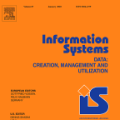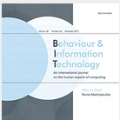计算机类 | SCI期刊专刊约稿信息4条
人机交互
Behaviour & Information Technology
Special Issue: Advanced Decision Making in Higher Education: Learning Analytics Research and Key Performance Indicators
全文截稿: 2017-11-20
影响因子: 1.388
CCF分类: C类
中科院JCR分区:
• 大类 : 工程技术 - 4区
• 小类 : 计算机:控制论 - 4区
网址: http://www.tandfonline.com/toc/tbit20/current
Behaviour & Information Technology seeks original manuscripts for a Special Issue on “ADVANCED DECISION MAKING IN HIGHER EDUCATION: LEARNING ANALYTICS RESEARCH AND KEY PERFORMANCE INDICATORS” scheduled to appear in an early 2018 issue.
From the well-defined scientific and application domain described as Information and Communication Technologies we focus on some of the most evolutionary technologies of the last years namely Learning Analytics and Cognitive Computing. These technologies and methodologies are in the focus of this special issue aiming to foster a scientific debate for the new era of Higher Education, where academic institutions would have to develop strategies for the adoption of technologies in the daily educational process beyond limitations and barriers promoting advanced decision making capabilities.
Learning Analytics and applications have received growing attention in recent years from various perspectives. The thriving numbers of Big Data creation in Higher Education have captured the attention of Higher Education, computer engineering and business researchers that, in the past years, have been trying to decipher the phenomenon of Higher Education Performance and Innovation, its relation to already-conducted research, and its implications for new research opportunities that effect innovations in teaching and higher education dynamics.
The current applications of Learning Analytics in Higher Education worldwide present a very interesting picture. Several medium/big scale information systems provide a variety of services to all the stakeholders in Higher Education institutions including students, professors, managers and professionals. A key strategic shift in the focus of education is evident, from a core-knowledge oriented education to a collaborative-dynamic evolving paradigm. It seems that we are in a crossroad where the traditional classroom based model of Higher Education must be critically enriched with technology enabled added value components. Toward this direction, it is critical to reveal hidden pattern in educational data, to develop, understand and measure key performance indicators and to promote sophisticated decision making
These widely-accepted Learning Analytics systems endeavors demonstrate that a wide range of decision making capabilities are available and present a viable and robust alternative to traditional strategies to Higher Education. In parallel several surveys in Higher Education directly link the response to students’ inefficiencies to the use of advanced analytics in Higher Education.
The objective of the special issue is to communicate and disseminate recent higher education, computer engineering, social, behavioral and business research and success stories that demonstrate the power of Learning Analytics to improve the Quality of Higher Education and the Decision making capabilities. The purpose of the special issue is to demonstrate state-of-the art approaches of Learning Analytics and to show how new, advanced, educational models and adoption strategies can expand the sustainability frontiers in advanced applied computer engineering and knowledge management towards Smart Education and knowledge society vision.
计算机科学与技术
Enterprise Information Systems
Special Issue - Collective Intelligence Related to Business Processes
全文截稿: 2017-12-30
影响因子: 1.908
中科院JCR分区:
• 大类 : 管理科学 - 2区
• 小类 : 计算机:信息系统 - 3区
网址: http://www.tandfonline.com/toc/teis20/current
How do the roles of collectives affect business processes?
What are the various methods and techniques of collective intelligence used in processing business data?
The motivation for this special issue is based on the growth of interests for the roles of collectives in business processes. Collective intelligence deals with the important role of the computational intelligence paradigms in creation, maintenance and use of information from different and autonomous sources.
Collective data means data originating from different and autonomous sources including text, numeric, images, video and other multimedia data. In most cases, such data are complex and their effective processing requires implementation of the advanced computational intelligence tools and techniques. Implementation of the above tools leads to creation of the intelligent information systems. In business systems processing of this kind of data is very important for making decisions.
The issue focuses on various methods and techniques of collective intelligence used in processing business data. Application of these methods and techniques is today considered as a key success factor in a majority of the enterprise information systems. These tools and techniques are used to enhance, support or replace traditional approaches to collective decision making in intelligent data mining, complex data analysis and managing data processing within enterprise information systems.
The objective of this special issue is to present state-of-the-art research in using collective intelligence techniques in processing business data for enterprise information systems. All theoretical and practical aspects regarding using collective intelligence methods to business processes, especially the methods and techniques related with, but not limited to:
- Business Intelligence
- Multi-criteria Decision making
- Group Decision Making
- Consensus Making
- Cognitive Modeling of Agent Systems
- Computer Vision
- Social Networks
- Distributed Intelligence
- Evolutionary computing
- Fuzzy Systems
- Grey Theory
- Information Retrieval and Integration
- Intelligent Image Processing
- Intelligent Networks
- Knowledge-Based Systems
- Machine Learning
- Mobile Intelligence
- Natural Language Processing
- Optimization and Swarm Intelligence
- Semantic Web
- Ubiquitous computing and its applications
- Web Intelligence and Interaction.
计算机科学与技术
Enterprise Information Systems
Special Issue - Integrated Design and Operations Management for Enterprise Systems
全文截稿: 2017-12-31
影响因子: 1.908
中科院JCR分区:
• 大类 : 管理科学 - 2区
• 小类 : 计算机:信息系统 - 3区
网址: http://www.tandfonline.com/toc/teis20/current
Enterprise Systems (ES)face changes in technologies, resources, and demands today more than ever before. This situation means the limit is being reached withthe traditional management of enterprise systems. A transformative new management approach is to consider changes of the structure of enterprise systems (i.e., design of enterprise systems) as a part of the (operation) management. As such, an currentissue is how to integrate the design and operation management of enterprise systems.
The conventional approach is that the design goes first, followed by operations management. This approach can easily reach the limit of the enterprise systems performance, particularly with todays increasing demand, which is not only affected by the time-based profit oriented function but also with the robustness, reliability, sustainability and resilience of an enterprise system.
The new approach is to integrate the design of an enterprise’s structure and the design of an enterprise’s management system for operations. The operation includes the following activities: leading, planning/scheduling, coordinating, and controlling. This special issue is intended to bring together the state-of-art research on this new approach.
Topics of the special issue include but not limited to:
- Fundamentals of integrated design and operations management.
- Performance measures of an enterprise system.
- Reliability of an enterprise system.
- Robustness of an enterprise system.
- Resilience of an enterprise system.
- Information systems for integrated design and operations management.
- Adaptive operations management systems.
- Robust operations management system.
- Resilient operations management system.
计算机科学与技术
Enterprise Information Systems
Special Issue - Interoperability Enablers for Cyber-Physical Enterprise Systems
全文截稿: 2017-12-31
影响因子: 1.908
中科院JCR分区:
• 大类 : 管理科学 - 2区
• 小类 : 计算机:信息系统 - 3区
网址: http://www.tandfonline.com/toc/teis20/current
This special issue seeks to bring together novel contributions from researchers and practitioners who are exploring the definition and applicability of Cyber-Physical Enterprise Systems Interoperability in a global perspective to contribute to reach the visionary Enterprise of the Future, putting focus on novel strategies, methods and tools in a scientific-based standpoint. Conceptual, theoretical, empirical and technological contributions are foreseen, illustrated by applied examples and convincingly demonstrating noteworthy novelty in comparison with previously reported results.
According to telecom giant CISCO, the Internet of Everything (IoE) is ‘‘bringing together people, process, data, and things to make networked connections more relevant and valuable than ever before, turning information into actions that create new capabilities, richer experiences, and unprecedented socio-economic and environmental opportunities for businesses and individuals’’.
In this context, the Future Internet-based Enterprise Information Systems can be defined as ‘‘a enterprise-centric network integrating and interoperating with proprietary and non-proprietary advanced technologies, computers, communication systems, control strategies as well as cognitive agents (both humans and/or advanced intelligent systems) able not only to manage people, processes and things, but also to generate new behaviors for adapting themselves to a dynamic market’’ (adapted from Davis et al, 2007) (Panetto et al, 2015). State-of-the-Art technology has empowered a systematical deployment of Cyber-Physical Systems (CPS) to the Enterprise Systems, enabling information from heterogeneous physical and virtual sources to be closely monitored and synchronized between the physical and the cyber-computational spaces, providing mechanisms for advanced information analytics with networked capabilities able to perform collaboratively, resiliently and more efficiently towards the visionary Enterprise of the Future (EoF).
Actually, the IoE is more than different Internets. It is a network of networks that aims to bring all together people, process, data, things (e.g. machines), and even services (e.g. virtual resources) in several possible combinations such as (Panetto et al, 2015): person-to-person (Pr2Pr) in social networks; person-to-process (Pr2Pc) with processes visualization in models, simulators, dashboards, widgets and/or cockpits; person-to-data (Pr2D) with semantic search accuracy; person-to-machine (Pr2M) with intelligent human-machine interfaces; person-to-service (Pr2S) with accessibility to digital services; process-to-process (Pc2Pc) with processes mashups; process-to-data (Pc2D) with enriched datasets for data analytics; process-to-machine (Pc2M) with improved automation and control of machines; process-to-service (Pc2S) with better virtual resources availability and utilization; data-to-data (D2D) for value-added metadata; data-to-machine (D2M) with higher performance of machines due to real-time and precise data streaming; data-to-service (D2S) for better (mass-)customization of digital services; machine-to-machine (M2M) aiming a totally integrated automation and control of equipment; machine-to-service (M2S) with complementary virtual resources available on the cloud on-demand; and service-to-service (S2S) with scalable resources also available in the cloud through their virtual resources integration.
In the advent of the CPS paradigm, the Future Internet-based Enterprise aims to manage and leverage on all possible networked connections among people, process, data, things and services to achieve its strategic goals with enhanced sensing physical and virtual capabilities. Such internet ecosystem depicts the emergence of new enhanced and holistic collaborative forms between people, process, data, things, and services and calls for new ‘‘systems of systems interoperability’’ (SOSI) solutions for novel Enterprise Information Systems with the IoE (adapted from Panetto et al, 2015). As enterprise systems evolve and become more complex, with more and enriched sensing capabilities, the need for novel strategies for interoperable operations, automated data interchange and coordinated seamless knowledge and behavior of large-scale enterprise systems becomes highly critical, depending clearly on the interoperability of its information systems, applications and interconnected Things. To achieve such holistic, adaptive and seamless intelligent enterprise environment there is a need to devise strategies that leverage applied research and technological developments on a more solid and rigorous science base.
登录查看更多
相关内容
信息系统(IS)是支持数据密集型应用程序的软件和硬件系统。《信息系统》杂志发表了有关信息系统的语言、数据模型、过程模型、算法、软件和硬件的设计和实现的文章。主题领域包括如ACM SIGMOD / PODS,VLDB,ICDE和ICDT / EDBT,以及来自数据挖掘/机器学习,与结构化数据协调的信息检索,互联网领域的数据相关问题以及云数据管理、业务流程管理、Web语义、视听信息系统、科学计算和数据科学。官网地址:http://dblp.uni-trier.de/db/journals/is/
Arxiv
16+阅读 · 2020年1月2日
Arxiv
10+阅读 · 2019年10月3日




